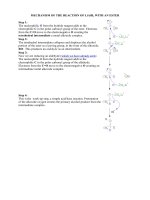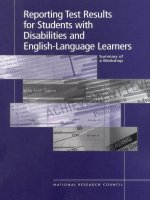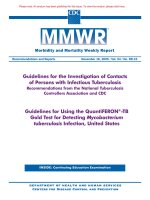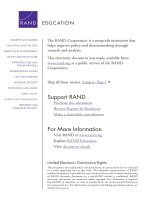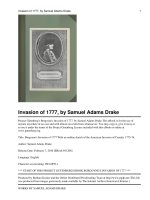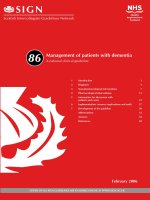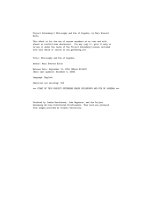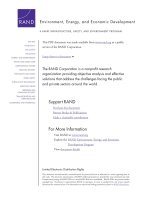Improving cultural behaving capacity of students with ecological environment through teaching Tran Nhan Tong’s poetry and FU
Bạn đang xem bản rút gọn của tài liệu. Xem và tải ngay bản đầy đủ của tài liệu tại đây (860.72 KB, 10 trang )
HNUE JOURNAL OF SCIENCE
Social Sciences, 2019, Volume 64, Issue 11, pp. 81-90
This paper is available online at
DOI: 10.18173/2354-1067.2019-0069
IMPROVING CULTURAL BEHAVING CAPACITY
OF STUDENTS WITH ECOLOGICAL ENVIRONMENT
THROUGH TEACHING TRAN NHAN TONG’S POETRY AND FU
Nguyen Thi Diem Kieu
Nguyen Thien Thanh High School for The Gifted, TraVinh province
Abstract. Tran Nhan Tong king, the great man in the Vietnamese history, is a
convergence of a politician, thinker, and poet. He was also the creator of Truc Lam
Zen School (Vietnam). By viewpoint in ecological criticism, studying the Tran
Nhan Tong's heritage about the poetry and fu is the wonderful combinational
between ecophilosophy and ecoculture. In this paper, we focus to study the
ecological values in poetry and fu of Nhan Tong king. The ideology and religion of
Tran Nhan Tong were Hòa quang đồng trần (Blend the light with the dust) and Cư
trần lạc đạo (Living in the world, joyful in the Way). His ecoculture was natural
ecology and spiritual ecology within the harmony between humans and nature.
With the determination values of national identity in ecological literature, teaching
and studying Tran Nhan Tong's poetry and fu in high school have important
missions. The research results are also applied to teach some works of this emperor
- poet, such as: Contemplate Thien Truong in the afternoon, Early spring
morning… The first role is the connecting medieval literature with the real life.
Another role supports students to develop the capacity of behaving with ecological
environment. The students will know that how to read the ecological literature and
how to manipulate the way of reading ecological literature.
Keywords: Ecocriticism, ecoliterature, ecophilosophy, natural ecological
environment, spiritual ecological environment.
1.
Introduction
The research issues related to the topic and the content of this paper are to study the
theory of ecological criticism and research on Tran Nhan Tong.
In theory of ecological criticism Ecological criticism, we were study at the ecological
critique of Cheryll Glotfelty [1], the concept of ecological culture, ecological philosophy,
ecological literature, and relationships between ecological culture and ecological literature,
between ecological culture and ecological environmental education of Xuyen Nhac Vuong
[2], Oriental ecology with unified natural thoughts of Luu Phuong [3], human ecology in
the time great 4.0 of Le Huy Bac [4]...
Received July 12, 2019. Revised September 7, 2019. Accepted October 12, 2019.
Contact Nguyen Thi Diem Kieu, e-mail address:
81
Nguyen Thi Diem Kieu
Researchs on Tran Nhan Tong had been Vietnamese Literature in the 10th century and
the first half of the eighteenth century (Dinh Gia Khanh and Bui Duy Tan, Mai Cao
Chuong) [5], Vietnamese medieval literature syllabus (La Nham Thin editor) [6]. Nguyen
Kim Son studied Tran Nhan Tong's Zen thought more or less indirectly related to
ecological criticism. In general, there are no articles studying Tran Nhan Tong's poems
from the perspective of ecological criticism and ecological environment education [7].
This article has two new. Firstly, the study Tran Nhan Tong's heritage and poetry from
an ecological critical is the combination of ecological philosophy and culture ecology,
people and nature. Secondly, teaching Tran Nhan Tong's poetry to develop cultural
behavior with ecological environment for students. This is a necessary of developing the
quality and capacity of students in current stage.
2.
Content
We can use ecological criticism to study Vietnamese medieval literature and Tran
Nhan Tong's works because there are two things: firstly, from the concept of ecological
criticism, ecological literature; secondly, and secondly, from the content of writing, the
objective meaning from the works of Tran Nhan Tong.
2.1. Conceptions
2.1.1. Concept of ecocriticism
Among various definitions of ecological criticism (hereinafter referred to as
ecocriticism), the most popular definition is from the American ecological critic - Cheryll
Glotfelty (1996): Ecological criticism is the critique of relationship between literature and
nature [1]. Thus, it is possible to apply ecological criticism to study the medieval literary
and Tran Nhan Tong’s poetry, fu because they raise the relationship between literature and
nature, in which literature shows the relationship between human and nature.
Ecocriticism follows two basic trends: the first trend is based on deep ecological
theory towards the centered ecological approach and natural preservation (topics of
nature, human in relations with the nature in terms of psychology, biology...). Deep
ecocriticism means based on the intention of renouncing the notion of human superiority
to nature, which sets human on a higher level than the nature; affirming the concept
“equal coexistence” between human and other organisms. The second trend is centered
social approach which relates to social issues such as industrialization, ethnicity, postcolonialism, etc. Social Ecocriticism is a global trend reflecting many critical issues of
human life not only in a nation but also in all over the world [8]. In Vietnamese medieval
literature and Tran Nhan Tong’s works, it is possible to study towards two above trends,
especially the first trend: deep ecocriticism.
2.1.2. Concept of ecoliterature
Ecological literature (ecoliterature) is understood in broad and narrow meanings. By
broad meaning, the ecoliterature is “traditional literary works with ecocultural
awareness”. These works do not directly refer to the term “ecology”, but they contain the
awareness of harmony between human and nature, the deep criticism about the
opposition and separation of people from the nature. By the narrow meaning, the work of
ecoliterature is “where the writer takes a clear ecological cultural position, pioneers to
82
Improving cultural behaving capacity of students with ecological environment through...
criticize the relationship between human and nature, directly reflects the threat of modern
ecology and send out the critical message” [2]. According to the broad meaning in
ecoliterature, the medieval literary world has a line of ecoliterature, Tran Nhan Tong's
works contains the features of ecoliterature although the author from seven centuries ago
did not aware of environmental and ecological issues.
Although the specific feature of ecological literature is reflection of nature,
ecoliterature is not simply a depiction of nature and people in the natural landscape,
literary works were about to find the solutions for the people to return harmoniously to
the world, towards the equality in the development of human and nature. In terms of the
objective meaning of the works (not the subjective consciousness of the author), many of
Vietnamese medieval writings and Tran Nhan Tong's literary works contain this
particular feature of ecoliterature.
2.2. Poetry and Fu of Tran Nhan Tong from ecocriticism perpective
First of all, Tran Nhan Tong is the great man as an emperor, a creator of Truc Lam
Zen School, a great poet of Tran dynasty.
2.2.1. Ecophilosophy
According to Wang Yuchuan, “ecophilosophy is the starting point of the argument
and the basis of ecocriticism” and what ecocriticism absorbs is ecophilosophy [2]. Karl
Kroeber also states: “The ecocriticism does not take ecology, biology, chemistry,
mathematics, or research methods of any other natural sciences into literary analysis. It
only introduces the most basic concept of ecophilosophy into literary criticism” (quoted
from Wang Yuchuan) [2]. Accordingly, the ecological literary works express the
ecoculture, pioneers to criticize the relationship between human and nature, the
awareness of harmony between human and nature, and criticize the opposition and
separation of people from the nature.
2.2.1.1. From the perspective of ecophilosophy, the poetry and Fu of Tran Nhan Tong
reflect the Buddhist cosmology with theory of Four Elements, the notion “unity of all
things” leading to the harmony between man and nature.
According to Buddhism theory of Four Elements, the world is made of four great
elements: earth, water, wind, and fire. The universe is a great block called the Great Soul
(Brahman). The Great Soul consists of various Small Souls (Atman). The Great Soul is
permanent, not alive, not die. The Small Souls after being released from the Great soul
have relatively independent lives and life transformation. Human as well as all other
objects are small souls born from the great soul with the same origin [9]. Accordingly,
“everything has the soul”, people do not perceive that the things around them (grass,
wood, lightning, rain...) are different from them. All the things have souls and there are
communication processes between them and human being.
According to the theory unity of all things, how the Macrocosm (nature) is structured
will be same as how the microcosm (human) is structured like [9]. Everything is not
created by the God but by the movement of itself. Such as a law of motion is the law of
causing and affecting. Everything can be created and die in the impermanence. Only
when the impermanent is enlightened, eternal realms, nirvana, unborn undying can be
achieved.
83
Nguyen Thi Diem Kieu
From a philosophical perspective, Tran Nhan Tong had thought and interpreted most
of the issues raised by Buddhism philosophy such as tangible, intangible, mind, budda,
life, and death, etc [10]. About the relationship between human and nature, Tran Nhan
Tong has shown the beauty of nature in harmony with human life. Human harmonized
with the nature, considered nature and human as “unity of all things” and the natural
world as whole without division and separation. Nature in Tran Nhan Tong’s poetry and
fu sometimes is a way to express the content of philosophy or sense of Zen. Sometimes,
nature becomes a real aesthetic object. However, nature is usually the feeling of the poet
expressing the sense of Zen.
The life of nature is with various shapes, all the things multiply: flowers bloom,
birds sing, rain falls, fresh grass which is extremely pure, free, noble, and different from
the ordinary life. The author perceives the nature with a calm and peaceful mind by
assuming that the essence of the universe is ruupa-emptiness (“sắc-không”) when the
mind reaches a level of absolutely calm, the transparent and silent mind can be integrated
into the essence of universe. The author finds that the nature is a place to nourish his
spirit and the desire to integrate eternally with nature. The author opens his mind with the
high mountains, moonlight, looking at the storks flying down to the field in the late
afternoon, and watching the butterfly in the spring on the fresh flowers with strong flavor
and color.
We can find these special Zen observation and Zen feel in the poetry: Contemplate
Thien Truong in the afternoon: Front and back of the village is smoky - In the shadow of
sunset, the scene is half there, half-not [11]. The Han verse expresses the Oriental
aesthetic sense: using the tangible thing to show the reality, the existing thing arises from
the empty thing.
Tran Nhan Tong has left many beautiful poems which are masterpieces in classical
Vietnamese poetry. There are the sentiments with the desire to integrate into the nature
and life. It is a humanist-centered dimension in Tran Nhan Tong's works and also in
Vietnamese medieval literature from ecocriticism perspective.
2.2.1.2. From ecophilosophy perspective, Tran Nhan Tong’s poetry and fu reflects the
Buddhism worldview with the concept of Blend the light with the dust and living in the
world, joyful in the way (in the mundane world, joyful in the way - attach to nature and
earthly life).
Living in the world, joyful in the Way is a Fu written in Chữ Nôm express the
ideology of Zen: in the mundane world feel happy in Zen world. It can be said that this
work is a declaration of the way of life set out by Dai Viet Buddhism and governed the
thought and life of the people at that time. In this poem, Tran Nhan Tong states that the
enlightenment is available in everyone and mentions the principle of self-enlightenment
by not running to catch (it means that running to find the way will never help to find it
out). At the end of fu, he mentioned the notion of “not running to catch”: Living in the
world, joyful in the way, let’s go with the causation flow - When hungry, eat - when
sleepy, sleep - Jewels in the home, search no more - Facing things, no mind, why ask for
Zen? [11]. The poem expresses a sense of the impermanence of life and the desire to be
liberated and achieve the virtue.
84
Improving cultural behaving capacity of students with ecological environment through...
The secret of Truc Lam Zen School is to keep the soul free. Free mind means no
influence from success, fail, gain and loss. Reaching such a free mood is achieving the
real security in which the mind cannot be affected by greed and hatred. Thus, Pure Land
is not far away but the self-purification. Zennist does not need to find Buddha in the
Western Paradise, he can find the Buddha in the soul.
From ecophilosophy perspective, with Buddhism viewpoints of “Blend the light with
the dust”, it is possible to see that Tran Nhan Tong’s mind is always towards the life,
towards the people and his mind is always sobbing for human suffering. This makes the
writings of Tran Nhan Tong be immersed in humanity, humanitarian spirit, and was
created a strong attraction to the heart of readers.
2.2.2. Cultural ecology
Ecocriticism leads to the perception of ecological culture with natural ecology and
spiritual ecology in Tran Nhan Tong’s poetry and fu.
2.2.2.1. Natural ecology in Tran Nhan Tong’s poetry and fu
According to Buddhism, the essence and the phenomenal world are not separated,
they are like water and waves; the waves are from water then come back to the water;
waves are water, on the surface water are waves. Essence is transformed into a visible
phenomenon just like water turns into waves.
The second issue in ontology is the phenomenal world is presented by Zen masters
from the origin of ruupa- emptiness. The things, phenomena appearing and perceived by
senses (shape, color…) are ruupa; the thing which goaway and cannot be perceived is
emptiness. There is emptiness in ruupa because the thing which appear with shape and
can be perceived (ruupa) is only a temporary phenomenon. There is ruupa in emptiness
because the phenomena and things disappear, their shapes cannot be seen but they do not
go away but returning to its eternal essence where it is not created and does not die [12].
These perceptions have led to the concept of living in harmony with nature and the
universe. The poet can be inspired by all natural scenes in everyday life. It is the spring
landscape in a small and empty temple where willow flowers fully bloom, the birds sing
slowly; the clouds are flying softly in the sky in the poem Spring Scene: In the dense
willow flowers, birds singing slowly - The house is painted by the shade, clouds is flying
– The guest comes not to raise concern - Standing in front of the handrail watching the
translucent blue sky at the horizon (translated from Han poetry) [11]. In such a quiet
scene, the guest is drawn into the natural landscape and does not inquire about humanity,
do not consult on Zen, but with the Zen master standing in front of the handrail with
many flower and overlook the blue sky in the horizon. The real scene in the sunset has
turned into a mind-scene. The guests and hosts are silent. The scenes and human mind
are harmonized.
2.2.2.2. Spiritual ecology in Tran Nhan Tong’s poetry and fu
The harmonious combination between Emperor and Zen master - poet has created a
rich and diverse spiritual ecological environment in Tran Nhan Tong. Specially, the
prominence is the attachment to the country, the people, the attachment with life and the
feelings with beauty. By reviewing the historical pages of Tran dynasty, the spirit Tran
Dynasty with determination to win with self-reliance, self-confidence have shown. So,
living in the magnanimous ecological environment of the radiant era, Tran Nhan Tong
85
Nguyen Thi Diem Kieu
had rhetoric poem. In the poetry Visit Chieu Lang in a spring (Chieu Lang is Tran Thai
Tong's tomb), Tran Nhan Tong recorded the image of the old soldier who was passionate
about telling the story of Nguyen Phong – a victory over the Nguyen troops during the
First Resistance: “The old soldiers with white hair until now - Often tells the story of
Nguyen Phong” (Tran Thai Tong has the name of Nguyen Phong)” (translated from Han
poetry) [11].
In the spiritual ecology of that dynasty, Tran Nhan Tong’s poetry also expressed
both the beauty in his spiritual life and the spiritual beauty of Vietnamese. There is the
harmony between the soft and hard power, aggressive and calm, strong action and deep
thinking. These were partly reflected in the poems, which Tran Nhan Tong wrote to
welcome the ambassadors of Nguyen (China), such as welcome Northern ambassador Ly
Tu Dien, see off Northern ambassadors Ly Trong Tan, Tieu Phuong Nhai, see off
Northern ambassadors Ma Hop and Kieu Nguyen Lang… In these poems, the words and
literal expressions are humble and soft, but the tongue expresses the spirit of equality in
the relationship, holding the national independence spirit of Dai Viet.
As Truc Lam founder, with the idea of “Blend the light with the dust”, Tran Nhan
Tong’s poetry expresses a spirit of earnest attachment to the life. Contemplate Thien
Truong in the afternoon contains full of Zen meaning, Zen scene but still brings to
readers an afternoon painting of Thien Truong, a soulful countryside of Vietnam: Front
and back of the village is smoky - In the shadow of sunset, the scene is half there, half-not
– In the flute of herd, buffalos come back home - Each pair of white stork landing in the
field [11].
With the view of Zen School, Thien Truong scene appears from the sense of ruupaemptiness of the Buddha: the afternoon looks half there, half-not, both real and virtual.
The scenes of front and behind the village blurred as covered by the smoke shows both
the reality of the scene with the sunset and the mist, and the virtual illusions of
Buddhism. The image of “buffalos come back home” is the real scene of the village in
the afternoon and brings the deep philosophy of Buddhism. The Buddha says, “It is like
herding buffalo, holding a stick and watch, not let it freely come into the rice pads of
people”. The image of the buffalo in the Buddhism scriptures has become the symbol of
the process of “taming the mind”.
In the Zen sense, Contemplate Thien Truong in the afternoon still expresses a
spiritual life towards life, moreover, towards earthly life with love of nature, love of
simple life, wild life [13]. The image of familiar village appearing lively comes from the
consciousness of the existence of life. The only sound (flute) dispels the silence. The
only motion (the stork landing in the field) brings the vigorous movement to the scene.
From the sound to the motion, all of them are active and transform Thien Truong scene
from the illusion of Zen to the real life.
2.3. Tran Nhan Tong’s poetry, fu and teaching cultural behavior towards
ecological environment for students
Donald Worster (1993) has pointed to the need for ecological research in literature.
He said that “Today, the global ecological risk was not in the system itself but were in
our cultural system. To overcome this danger, we must strive to explain the effect of our
culture with the nature. So, the historians, literary critics, anthropologists, and the
86
Improving cultural behaving capacity of students with ecological environment through...
philosophers need to study relationship between the culture and ecology. They cannot
directly promote the cultural revolution, but can help us to explain some problems which
was precisely the premise of the cultural revolution” [13].
In the current context of renovation of curriculum, textbooks and teaching methods,
developing cultural behavior with ecological environment through teaching Tran Nhan
Tong’s poetry and fu is necessary for high school students.
2.3.1. Building teaching method for ecoliterature
The concept of the universe and humanity of Buddhism in Tran Nhan Tong’s poetry
and fu is expressed through the images of nature, rustic life; it is not simply using the
philosophical terms and propositions. By studying Tran Nhan Tong’s poetry and fu, from
ecocriticism perspective, we propose a process of reading ecoliterature as follow:
- Identify the relationship between people and the environment expressed in
literary works (equality or inequality - human is center or nature is center).
- Identify, analyze the environmental symbols - language in the works (words,
artistic images).
- Build aesthetic attitudes and feelings towards the ecological environment.
Contemplate Thien Truong in the afternoon is a typical example of poetry written
about nature in Tran dynasty. The poetry with Zen color was composed in the light of
introspective thought which links and attaches to real life. The students need to recognize
the relationship between human and environment expressed in the poetry. This is the
relationship between the lyrical characters (the author) and the nature and village
landscape, a close relationship described as “Love in the scene, the scene in the love”.
Reading ecoliterature, students need to identify and analyze the environmental
symbols - language in the works through words, artistic image
Contemplate Thien Truong in the afternoon, if the first two verses express the quiet
of the scene, bearing the stamp of religious feelings; the next two verses with the image
of buffalo coming back to the village, each pair of storks landing in the field express the
motion showing the existence of life, the dominance of ruupa to emptiness and the
motion to the quiet. The flute breaks the quiet of the scene, makes it more alive. These
are the vivid sounds and familiar images of life.
The sound of the flute, which is considered as the call of life, helps the Zen master
awake after the minutes of Zen; the image of white storks, each pair landing in the field
is a vivid expression of an active incarnation. The words: “pairs” and”each pair” are a
manifestation of the proliferation, the beauty of life that the Zen master wants readers to
be drunk into. Along with the transformation of the scene, the Zen master also wants to
express the transformation of his own consciousness from the virtual to the real, from the
invisible to visible, thereby affirms the existence of the world.
2.3.2. Building the cultural behavior with the environment
2.3.2.1. The students listen to the sound of nature: plants, animals have their own voice,
people need to listen and understand them.
The poetry Early spring morning by Tran Nhan Tong is an example: Wake up and
open the window - Unbelievably the spring has come - A pair of white butterfly – The
flapping wings fly to flowers. Natural language is represented by the spring image, such
87
Nguyen Thi Diem Kieu
as white butterflies fly to the flowers. All the things are cheerful, full of vitality in the
spring: blossoming flowers, paired butterflies are engaged to welcome the spring. The
image of a pair of white butterflies flying to the flower is the love language of animals in
the natural world. The poet listens, understands and then his soul is filled with spring
color and spring love.
Respecting the eternal law of nature is a way for people to live harmoniously with
the world. The concept of living in harmony with the nature has changed the belief of
human dominion over the nature. Therefore, this concept will bring the value of the
enlightenment and perceptive meaning, which can change human behavior with the
nature at the present and in the future.
2.3.2.2. Improving cultural behaving capacity of students with ecological environment is
to create in the “safe” and “unsafe” mind-set in the natural environment.
One of the central factor in ecoliterature is evaluation the ideals, cultures and social
development models of human being that affect to the nature. Human is the product of
nature, when faced the power of nature, human have the survival instinct which reminds
about the position of human in the natural order [14, 15]. From this view point, teaching
Tran Nhan Tong’s poetry and fu can contribute to protest the thought of human
dominance over the nature, the thought that people live peacefully in the nature and will
be unsafe when the nature is destroyed.
From the peaceful countryside scene with the buffalo and village, the image of the
storks landing in the field in Contemplate Thien Truong in the afternoon, the students
with a safe mind-set can drop their souls into the nature, peaceful environment existing
for thousands of years with the image of white stork in the fork song: “The storks fly and
fly - Fly from the door to the field”, and the image of buffalo plowing the field, storks in
the poetry of Thai Thuan, Hong Duc Dynasty in the later half of the fifteenth century:
The tide flooded the land- The farmer wakes up early to plow the field - Listen to some
voice pushing the buffalo - White storks are startled to fly [11].
From the image of the storks from peaceful life in Tran Nhan Tong’s poetry, in the
fork song and Thai Thuan’s poetry, the students realize the panic storks in the war from
the poetry The other side of Duong River by Hoang Cam: “There is a white stork fly
rapidly – Surf across Duong river to nowhere”.
From “safe” or “unsafe” mind-set, the students can be anxious when the natural
and social environment were destroyed, through which will criticize someone who
destroyed natural environment.
Through the above analysis, it is possible to teach lesson Contemplate Thien
Truong in the afternoon to form a culture environmental for high school students in the
following steps: 1. Feel the beauty of the image of your village with your neighbors,
fields, buffaloes, storks… close and familiar; 2. The harmony between man and nature;
3. Cherish and appreciate the beauty of nature; 4. Preserve the natural beauty of nature
and life.
2.3.2.3. Improving cultural behaving capacity of students with ecological environment is
to help the students to become the protectors of ecological environment
Although the works was written in the period when ecological crisis was not a hot
issue, Tran Nhan Tong's works have mentioned many issues of relationship between
88
Improving cultural behaving capacity of students with ecological environment through...
human and nature. The harmonious relationship between human and nature in Tran Nhan
Tong’s poetry and fu evokes the students with their thoughts and comparisons about the
conflict between industrial civilization and nature. The underlying ecological
implications in Tran Nhan Tong's works have great value to awake people, educate
students become the environment protectors to save this planet.
3.
Conclusions
Improving cultural behaving capacity of students with ecological environment for
students through teaching Tran Nhan Tong’s poetry and fu will help the learners to
discover the values of national identity. They can play the role as a bridge to connect
medieval literature and the realities of life. It notonly diversifies the learning forms, but
also helps to acquire knowledge more effectively. Thereby, the concepts of ecological
environment, cultural behavior and ecological environment are not limited to the subject
Citizen Education, Biology but also in Literature, increasing the awareness of the student
to preserve the natural environment, living space, cultural space for human development,
raising living standard, human personality.
Teaching in the cultural behaving capacity of students with the ecological
environment through Tran Nhan Tong’s poetry and fu were a new viewpoint, that can
reveals new values with practical meaning. It can increase the position of Tran Nhan
Tong to a new level in history, in the literature, and our lives.
However, the subject of Literature in the high school, ecological criticism is still a
new issue, so, the application of ecological criticism theory in the study of teaching Tran
Nhan Tong’s poetry and fu are the right way for raising awareness and actions of
students to protect the environment.
REFERENCES
[1] Cheryll Glotfelty & Harold Fromm, 1996. The ecocriticism Reader: Landmarks in
literary ecology. The University of Georgia Press, p.18
[2] Xuyen. N. V., 2016. Ecological literature and ecological critique, 22-25.
Vietnamese Education publisher.
[3] Phuong Luu, 2017. The unity of nature and human from Perspectives of
Ecocriticism. Ecocriticism: local and global voices (International Conference
Proceedings). Social sciences Publishing house, Ha Noi.
[4] Le Huy Bac, 2017. Signs of Humanity an Ecology 4.0. Ecocriticism: local and
global voices (International Conference Proceedings). Social sciences Publishing
house, Ha Noi.
[5] Dinh Gia Khanh, Bui Duy Tan and Mai Cao Chuong, 1997. Vietnamese Literature
(from X century to first haft XVIII century). Education Publisher.
[6] Thin, N. La. (editor), 2011. Curriculum Literature of Vietnam's Middle. Vietnamese
Education Publisher.
89
Nguyen Thi Diem Kieu
[7] Nguyen Kim Son, 2012. The unificationof zen and poetic inspiration, or the joy an
empty heart – on three poems on the sunset by Tran Nhan Tong. Literature Studies,
No.5.
[8] Do Van Hieu, 2013. Ecological critique-The origin and development. [Cited 5
May 2018]. Available from URL />[9] Nguyen Lang, 2018. Vietnam-Buddhism, comprehensive treatise, 225-312. Literary
publisher.
[10] Pham Quynh, 2016. Interpretation of literature and philosophy, 417-508. Literary
publisher.
[11] Uy ban khoa hoc xa hoi Viet Nam, Vien van hoc, (1988). Poetry of Ly – Tran.
Hanoi Social Science publisher, Vol. 2, page 451-551. Available from URL:
/>[12] Nguyen Cong Ly, 2016. Buddhist literature of the Ly - Tran period: Appearance
and characteristics. Vietnam National University Publisher, Ho Chi Minh
City. [Cited
5
June
2018].
Available
from
URL:
/>[13] Donald, W., 1993. The Wealth of Nature: Environmental History and the
Ecological Imagination, 27-29. Oxford University Press.
[14] Kerridge, R & Sammells, N., 1998. Writing the Environment: ecocriticism and
literature, 9-10. Zed book Press.
[15] Jacques, V., 2002. Ecological environment, 10-22. Ha Noi World publisher.
90

